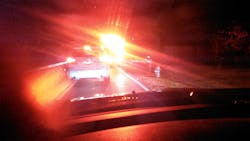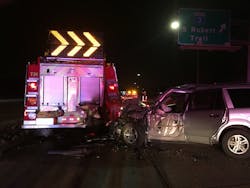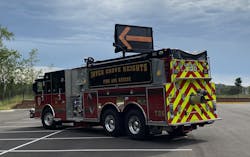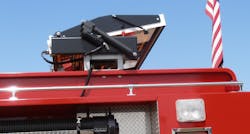Fire officers nationwide are telling me that their departments are responding to far more road and highway incidents than structure fires nowadays. Unfortunately, operating on roads and highways is extremely dangerous. According to the Emergency Responder Safety Institute (ERSI), which is a committee of the Cumberland Valley Volunteer Firemen’s Association, 65 emergency responders were struck and killed while they operated at roadway incidents in 2021. As of July 2022, 29 emergency responders were struck and killed this year, and an unknown number of emergency personnel were struck and injured by vehicles while those individuals worked roadway incidents. This increases the importance of emergency and scene lighting plays in protecting firefighters, EMTs, motorists and the victims of incidents who they assist along the highway.
Of course, almost every emergency vehicle is equipped with emergency warning lights, and those warning lights come in many configurations and in one or more of several colors that are assigned by each state for specific emergency service vehicles. Those warning lights serve two basic purposes: expedite response to an emergency scene and, once on scene, warn approaching motorists of an unusual situation up ahead.
When we respond to emergency incidents, we want emergency warning lights to attract as much attention as possible to get drivers attention from a distance. This way, drivers yield the right of way and allow us to pass, so we can navigate through intersections safely. Bigger, brighter, faster flashing lights are the order of the day. However, when our unit arrives at the incident scene, ideally, warning lights should serve a different purpose: warn motorists of our location and provide them with guidance about what they should do as they approach the work area. (Every state now has some kind of “Move Over” law that requires motorists to move away from the lane where the work area is located or at least to slow down if they can’t shift lanes safely.)
Many times, our bigger, brighter, faster flashing lights look like a purple blob of light in the distance, and as drivers get closer, those same lights can become an additional hazard for firefighters who work the crash, fire or medical emergency. Drivers report that new warning lights are too bright in low light and nighttime conditions and create glare that prevents them from seeing where emergency personnel are working. Those same warning lights do little, if anything, to show motorists where they should go to pass the incident safely.
ERSI recently completed its “Effects of Emergency Vehicle Lighting Characteristics on Driver Perception and Behavior” study, which was funded by the U.S. Fire Administration (USFA). The study confirmed that higher intensity warning lights present more glare, but those higher intensities don’t necessarily make the lights more visible at night. Lower intensity lights, the study indicated, provide the same level of visibility as higher intensity lights do under nighttime conditions.
The study found that the perceived level of visibility of the lights is more related to color. Blue and red lights have the greatest perceived saturation and are judged to be brighter than white and yellow lights of the same intensity. At the same time, blue and white lights were judged to be more glaring (in other words, more annoying), and red and yellow lights were the least glaring at the same intensity levels.
The emergency warning light study further found that lights that meet existing minimum intensity requirements for emergency vehicles might be brighter than needed for nighttime driving conditions, particularly when emergency vehicles are stationary. This means that using lower intensities at night or in low-light situations reduces discomfort glare without reducing visibility.
Warning lights typically operate at 100 percent modulation during a flash sequence: 100 percent on, 100 percent off, 100 percent on, 100 percent off, etc. At nighttime, the modulation of the flash pattern is most effective when the level of intensity is less than the 100 percent of the daylight intensity, and it never goes below 10 percent during the flash sequence, so the flash pattern looks like 50 percent on, 10 percent on, 50 percent on, 10 percent on, etc. The intensity and modulation of the flashing lights can be controlled manually with switches or automatically using ambient light sensors.
Most emergency lighting manufacturers can provide systems that control intensity of warning lights, flash rate and choice of colors that are displayed. Discussions with a lighting vendor and/or apparatus manufacturer can lead to ways to get the maximum value and effectiveness out of an emergency lighting system that’s on current apparatus and to thoroughly investigate the technology when developing specifications for any new apparatus. The crux of these discussions: Lower intensity (dimmer) lights and slower flash rates still are visible from a distance at night but are less annoying for passing motorists, who now can see personnel who are working around the apparatus and work area more easily—if drivers pay attention to where they are going in the first place.Reflective chevrons
One of the other aspects of the study was to assess the “moth-to-flame” phenomenon that some firefighters believe draws motorists toward emergency lights on apparatus that are parked at incident scenes. However, the researchers found no evidence to support or refute a moth-to-flame effect within the criteria of this study.
There was one surprising finding of the study that wasn’t part of the planned research. Highly reflective chevron markings (a line or stripe in the shape of an inverted V) in combination with the warning lights seemed to make it more difficult for drivers to see responders who worked around their emergency vehicles at night, even when the responders were wearing high-visibility vests. The combination of intense warning light flashes and the highly reflective chevrons developed enough glare so that it was difficult to see emergency personnel. That finding prompted the USFA to request a further study of the chevrons and reflective graphics that are used on fire apparatus, which now is underway. In the meantime, the researchers suggest consideration of a lower grade of reflectivity for the chevrons on new apparatus that’s being designed or built.Arrow boards and flares
For scene safety, one of the most effective lights for directing traffic around an incident is an arrow board that displays a large flashing arrow that points drivers in the direction that they should merge to safely pass the incident scene. Flashing emergency warning lights by themselves don’t provide any guidance for motorists about which way they should go to navigate around the scene.
The arrow board can be mounted on fire apparatus or a trailer or be displayed by a separate vehicle, such as a pickup truck or a utility, safety service patrol or fire police vehicle.
Another effective type of nighttime scene lights is the new versions of electronic flares. They are brighter, more compact and longer-lasting than traditional flares. Multiple light colors, flash speeds and intensities distinguish them from traditional flares. In fact, synchronization of flash patterns is available; a series of flares can create an appearance that’s similar to airport runway landing lights.
These electronic flares can be attached to road cones for enhanced visibility or even deployed under the cones to illuminate the whole cone itself, which increases their visibility for approaching motorists.
New electronic flares can help to get the attention of motorists in advance of an emergency ahead and to guide motorists in the direction that they must go to safely pass an incident scene. An additional benefit is their environmental friendliness, given that they don’t produce fumes or smoke.Helping personnel on scene
On-apparatus work lights (floodlights and spotlights), undercarriage puddle lights, compartment lights and portable work lights play a critical role in helping personnel avoid fall and tripping hazards at night and in low light conditions at the incident scene.
Floodlights and spotlights should be arranged and aimed so that they don’t create additional glare hazards for motorists yet illuminate the work area for emergency personnel. Although you should consider designing these into new apparatus, there are economical ways to add some of these lights to existing apparatus that didn’t come with them from the factory.
About the Author

Jack Sullivan
John (Jack) Sullivan is a subject matter expert on highway-incident operations and emergency personnel safety. He was a volunteer firefighter and chief officer for 25 years and recently retired from a 40-year career as a safety and loss control consultant for the public and private sector. Sullivan teaches Traffic Incident Management & Responder Safety Workshops for emergency responders for the Emergency Responder Safety Institute. He is a Master Instructor for the Federal Highway Administration’s SHRP2 Traffic Incident Management Train-the-Trainer Workshops. Sullivan is a Technical Member of the National Committee on Uniform Traffic Control Devices and serves as the chair of Committee’s Task Group for Chapter 6i (Control of Traffic Through Traffic Incident Management Areas) of the Manual on Uniform Traffic Control Devices.



